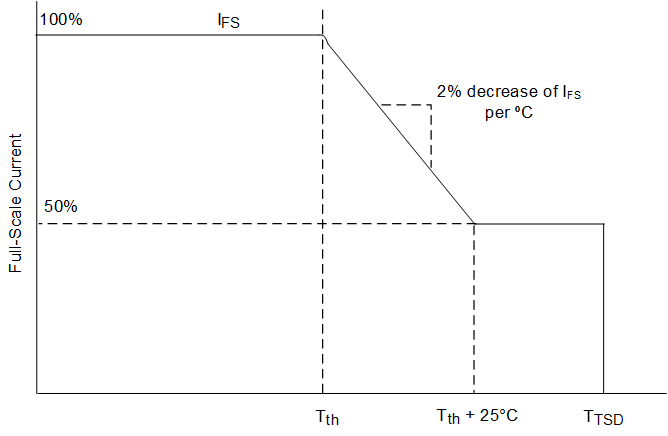SLVSH98A July 2023 – November 2023 LP8868U-Q1 , LP8868V-Q1 , LP8868W-Q1 , LP8868X-Q1 , LP8868Y-Q1 , LP8868Z-Q1
PRODUCTION DATA
- 1
- 1 Features
- 2 Applications
- 3 Description
- 4 Comparison Table
- 5 Pin Configuration and Functions
- 6 Specifications
- 7 Detailed Description
-
8 Application and Implementation
- 8.1 Application Information
- 8.2 Typical Application
- 8.3 Power Supply Recommendations
- 8.4 Layout
- 9 Device and Documentation Support
- 10Revision History
- 11Mechanical, Packaging, and Orderable Information
Package Options
Mechanical Data (Package|Pins)
- DMT|14
Thermal pad, mechanical data (Package|Pins)
- DMT|14
Orderable Information
7.3.7 Thermal Foldback
The LP8868 family integrates thermal shutdown protection to prevent the device from overheating. In order to provide design margin of system thermal performance, the device enables a programmable thermal foldback function which automatically reduces the full-scale output current, IFS, at high junction temperature. When the device along with the LEDs are mounted on the same thermal substrate, the thermal performance is effectively improved due to the reduction of dissipation need for both and LED.
As the junction temperature rises above the thermal foldback threshold temperature, Tth, the full-scale current starts to reduce following the current-temperature curve shown in the below figure. The current starts to reduce from the 100% level at typically rate of 2% of IFS per °C until it drops to 50% of the full scale. Once the junction temperature rises 25°C above the Tth, the current continues to decrease at a lower rate until the temperature reaches above the overtemperature shutdown threshold temperature, TTSD.
 Figure 7-4 Thermal
Foldback
Figure 7-4 Thermal
FoldbackThe Tth can be adjusted by changing the resistor RTEMP connected between the TEMP and GND pin. The Tth and the corresponding RTEMP value are listed in below table.
| Tth (°C) | Resistor Value (kΩ) |
| 80 | 200 |
| 90 | 100 |
| 100 | 60 |
| 110 | 40 |
| 120 | 28 |
| 130 | 20 |
| 140 | 15 |
| 150 | 10 |